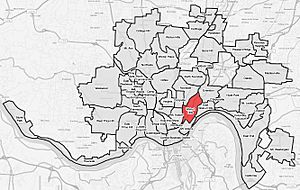Walnut Hills, Cincinnati facts for kids
Quick facts for kids
Walnut Hills
|
|
|---|---|
|
Neighborhood of Cincinnati
|
|

Walnut Hills Branch Library
|
|

Walnut Hills (red) within Cincinnati, Ohio.
|
|
| Country | United States |
| State | Ohio |
| City | Cincinnati |
| Population
(2020)
|
|
| • Total | 6,344 |
Walnut Hills is a cool neighborhood in Cincinnati, Ohio. It's one of the city's oldest areas, located on a hill on the east side of Cincinnati. Many different kinds of people live here. In 2020, about 6,344 people called Walnut Hills home.
Contents
The History of Walnut Hills
This neighborhood got its name from a farm. An early settler, Reverend James Kemper, called his farm "Walnut Hill." His family, the Kempers, lived in the Kemper Log House for many years. Walnut Hills officially became part of the City of Cincinnati in September 1869.
After the year 1900, more people started moving to Walnut Hills. Many Jewish and Italian families came from downtown Cincinnati. One part of the neighborhood was even known as "Little Italy."
Later, in the 1930s, many African American families moved to Walnut Hills. This happened after new buildings and projects in the West End of Cincinnati meant people needed new homes.
After World War II, many middle-class white families moved to new suburbs. Later, some middle-class African American families also moved out. By 1970, almost 80% of the people living in Walnut Hills were African American.
Cool Historic Places
Walnut Hills has many important historic spots. The Harriet Beecher Stowe House is one of them. This is where Harriet Beecher Stowe lived with her family. She also wrote her famous book, Uncle Tom's Cabin, here.
The Walnut Hills Library was Cincinnati's first Carnegie Library. The remaining tower of the Walnut Hills United Presbyterian Church was also designed by a famous architect named Samuel Hannaford.
Peebles' Corner was once a very busy area. It was almost as busy as downtown Cincinnati! Six different streetcar lines met there by the late 1800s.
The first building for Walnut Hills High School is also in this neighborhood.
Several parts of Walnut Hills are listed as historic districts. This means they are special and protected because of their history. Some of these include the Gilbert-Sinton Historic District, Gilbert Row, and Peeble's Corner Historic District.
Who Lives in Walnut Hills?
| Population of Walnut Hills 1900-2020 | ||
|---|---|---|
| Year | Pop. | ±% |
| 1900 | 16,136 | — |
| 1910 | 18,018 | +11.7% |
| 1920 | 21,125 | +17.2% |
| 1930 | 21,545 | +2.0% |
| 1940 | 22,824 | +5.9% |
| 1950 | 23,369 | +2.4% |
| 1960 | 20,658 | −11.6% |
| 1970 | 14,049 | −32.0% |
| 1980 | 9,907 | −29.5% |
| 1990 | 8,917 | −10.0% |
| 2000 | 7,790 | −12.6% |
| 2010 | 6,495 | −16.6% |
| 2020 | 6,344 | −2.3% |
In 2020, a count of the population (called a census) showed 6,344 people living in Walnut Hills. There were 4,223 homes in the neighborhood.
The people living there came from many different backgrounds. About 32.8% were White, and 60.1% were Black or African American. A small number were Native American (0.2%), Asian (1.4%), or Pacific Islander (0.1%). About 0.8% were from another background, and 4.7% were from two or more backgrounds. Around 2.4% of the people were Hispanic or Latino.
There were 3,777 households in total. About 32.6% of these were families. Most households, around 65.7%, were made up of single people.
Looking at ages, 12.7% of the people were under 18 years old. Most people, 71.8%, were between 18 and 64. About 15.5% were 65 years or older. Slightly more than half the population (51.5%) were female, and 48.5% were male.
The average yearly income for a household in Walnut Hills was about $30,259 between 2016 and 2020. About 30.5% of families were living below the poverty line. This means they had a lower income. Also, about 27.8% of adults had finished college with a bachelor's degree or higher.
Famous People from Walnut Hills
- Harriet Beecher Stowe, a writer and activist who worked to end slavery.

